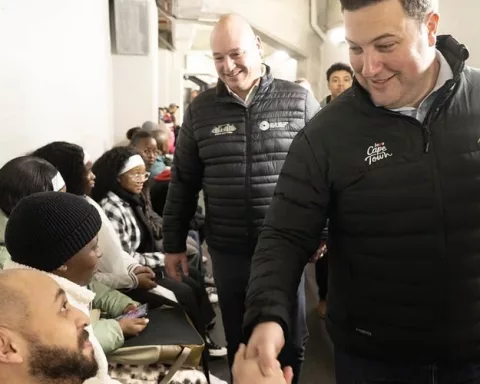South Africa faces a national emergency of youth unemployment, with over 50% of young people unemployed. At a gathering in Johannesburg, Minister Sindisiwe Chikunga outlined the government’s Presidential Youth Employment Initiative (PYEI), calling for a multi-pronged approach to address structural issues behind youth unemployment. The Minister stressed the importance of large-scale catalyst interventions, upskilling and reskilling youth, and drawing lessons from successful job creation strategies in Asian nations. The PYEI seeks to empower the youth for a brighter future and secure a better future for South Africa.
What is South Africa’s Presidential Youth Employment Initiative?
Learn about South Africa’s Presidential Youth Employment Initiative (PYEI) and the government’s call for a multi-pronged approach to combat youth unemployment. Minister Sindisiwe Chikunga emphasizes the need for large-scale catalyst interventions, upskilling and reskilling youth, and drawing lessons from successful job creation strategies in Asian nations. The PYEI seeks to address the structural issues behind youth unemployment and empower the youth for a brighter future.
In the vibrant heart of Johannesburg, at the Protea Hotel, Balaika Sandton, a distinguished assembly of scholars, activists, and intellectuals convened. The purpose of this gathering was a constructive discussion on the Presidential Youth Employment Initiative (PYEI). The spotlight was on the Hon. Sindisiwe Chikunga, MP, Minister of Women, Youth, and Persons with Disabilities. Minister Chikunga’s discourse demonstrated an in-depth grasp of the pressing issue: the national emergency of youth unemployment that necessitates immediate, inventive, and collaborative solutions.
Understanding The Grim Reality
As Minister Chikunga took to the stage, she acknowledged the severity of the circumstance. As she pointed out, South Africa’s youth unemployment ratio had alarmingly escalated over 50% – a predicament necessitating swift action. However, Minister Chikunga’s speech was not merely a recitation of bleak statistics; it was a rallying cry for a combined, well-planned, and tactical approach to combat youth unemployment.
Minister Chikunga beseeched her audience, consisting of academics, activists, practitioners, and recipients, to contemplate the pivotal factors that compound youth unemployment. She emphasized the intersections of gender, class, and race that result in unequal labour market outcomes. However, her call to action extended beyond these points. She encouraged self-reflection on the efficacy of previous attempts, pushing her audience to be unflinchingly honest about the successful and unsuccessful strategies.
Addressing The Challenges
Minister Chikunga shifted the spotlight to the unsettling unemployment numbers, particularly the issue of gender disparity in the labour market. The latest data displayed an unfavorable pattern: the employment rate of young men surpassed that of young women, with the unemployment ratio among young females estimated at 49.4% in 2024, marking a significant upswing from 46.1%.
Beyond these gloomy statistics, the Minister’s speech emphasized a critical point: the President’s proclamation of youth unemployment as a national crisis was not just about the figures. It concerned the structural issues behind youth unemployment and the absence of a structural reaction. The President’s call advocated a change in the existing paradigm – a shift from conventional procedures towards envisioning more structured responses that didn’t solely depend on available jobs but also promoted the creation of new ones.
The Way Forward: A Multifaceted Approach
Minister Chikunga stressed the importance of designing large-scale, catalyst interventions that would firmly root the country towards a future of sustainable development. She advocated for concerted and purposeful resource cultivation, stressing the implementation of interventions capable of persisting into the future.
Addressing the dilemma of unemployed graduates, she highlighted the peculiar scenario where even engineering graduates were jobless. The Minister proposed forceful solutions to capitalize on the numerous upcoming infrastructure projects, underlining the need for upskilling, reskilling, and placement of the youth through emerging industrialist apprenticeships.
Minister Chikunga’s remedy was categorical: a multi-pronged approach was necessary to combat youth unemployment. This included guaranteeing access to land for women and youth for agricultural purposes, establishing an emerging industrialist fund to translate ideas and innovation into productive economic activities, engaging with all jobless graduates, utilizing the mining sector for wealth redistribution, and leveraging public procurement to provide off-take for businesses owned by youth and women.
Learning From Others
Drawing parallels from Asian nations like Japan, South Korea, China, and Singapore, Minister Chikunga demonstrated how these countries had transformed burgeoning industries into formidable catalysts for economic growth and job creation. The strategies adopted by these countries, including strategic government intervention, policy support for budding industries, export-oriented industrialization, investments in education and skill development, and the role of the government as an initial investor, posed valuable lessons for South Africa.
Ultimately, Minister Chikunga’s speech was a clarion call to action. A call for audacious, decisive measures to address a crisis that could no longer be overlooked. She made it clear that the Presidential Youth Employment Initiative was not just a program but a mission – a mission to uplift the youth, empower them, and secure a brighter future for South Africa. It’s high time that we heed this call.
- What is South Africa’s Presidential Youth Employment Initiative?
-
The Presidential Youth Employment Initiative (PYEI) is a government initiative that seeks to address the structural issues behind youth unemployment in South Africa. It calls for a multi-pronged approach that involves large-scale catalyst interventions, upskilling and reskilling youth, and drawing lessons from successful job creation strategies in Asian nations.
-
What is the current youth unemployment rate in South Africa?
-
According to recent statistics, the youth unemployment rate in South Africa has escalated over 50%.
-
What are the factors that compound youth unemployment in South Africa?
-
Minister Sindisiwe Chikunga emphasized the intersections of gender, class, and race that result in unequal labor market outcomes as factors that compound youth unemployment in South Africa.
-
What are some of the solutions proposed by Minister Chikunga to combat youth unemployment?
-
Minister Chikunga proposed a multi-pronged approach that includes large-scale catalyst interventions, upskilling and reskilling youth, and drawing lessons from successful job creation strategies in Asian nations. The approach also involves guaranteeing access to land for women and youth for agricultural purposes, establishing an emerging industrialist fund, engaging with all jobless graduates, utilizing the mining sector, and leveraging public procurement to provide off-take for businesses owned by youth and women.
-
What can South Africa learn from successful job creation strategies in Asian nations?
-
Minister Chikunga highlighted the strategies adopted by Asian nations like Japan, South Korea, China, and Singapore, including strategic government intervention, policy support for budding industries, export-oriented industrialization, investments in education and skill development, and the role of the government as an initial investor.
-
What is the goal of South Africa’s Presidential Youth Employment Initiative?
- The goal of the PYEI is to empower the youth for a brighter future and secure a better future for South Africa by addressing the structural issues behind youth unemployment and implementing a multi-pronged approach that involves large-scale catalyst interventions, upskilling and reskilling youth, and drawing lessons from successful job creation strategies in Asian nations.












